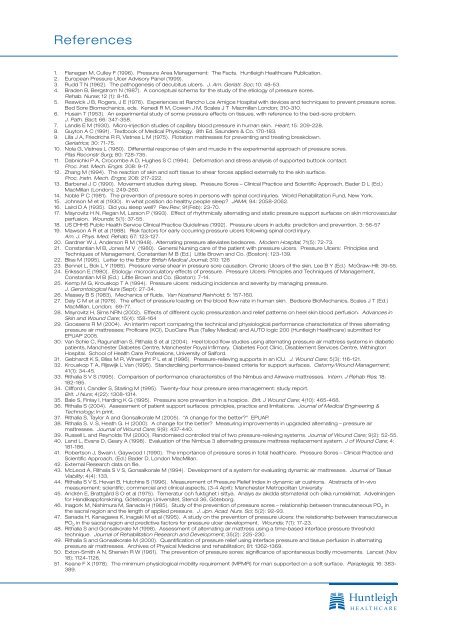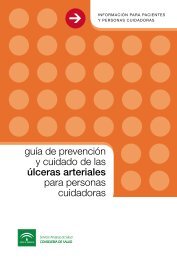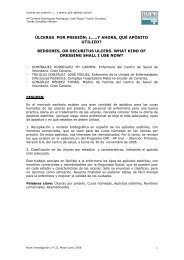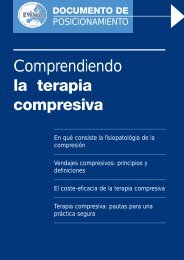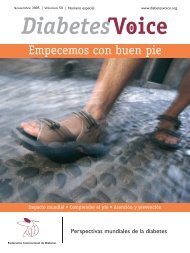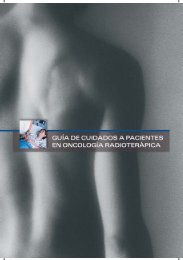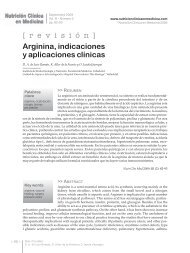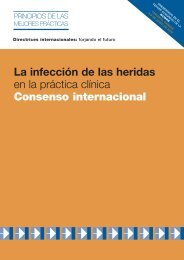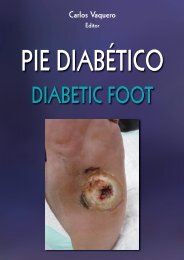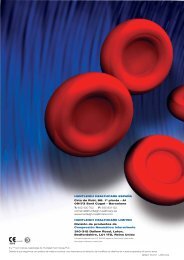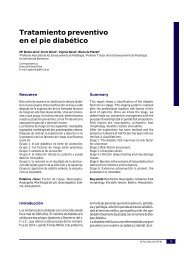HUNTLEIGH HEALTHCARE LIMITED Pressure Area Care Products ...
HUNTLEIGH HEALTHCARE LIMITED Pressure Area Care Products ...
HUNTLEIGH HEALTHCARE LIMITED Pressure Area Care Products ...
You also want an ePaper? Increase the reach of your titles
YUMPU automatically turns print PDFs into web optimized ePapers that Google loves.
References<br />
1. Flanagan M, Culley F (1996). <strong>Pressure</strong> <strong>Area</strong> Management: The Facts. Huntleigh Healthcare Publication.<br />
2. European <strong>Pressure</strong> Ulcer Advisory Panel (1999).<br />
3. Rudd T N (1962). The pathogenesis of decubitus ulcers. J. Am. Geriatr. Soc; 10: 48-53.<br />
4. Braden B, Bergstrom N (1987). A conceptual schema for the study of the etiology of pressure sores.<br />
Rehab. Nurse; 12 (1): 8-16.<br />
5. Reswick J B, Rogers, J E (1976). Experiences at Rancho Los Amigos Hospital with devices and techniques to prevent pressure sores.<br />
Bed Sore Biomechanics, eds. Kenedi R M, Cowen J M, Scales J T Macmillan London; 310-310.<br />
6. Husain T (1953). An experimental study of some pressure effects on tissues, with reference to the bed-sore problem.<br />
J. Path. Bact; 66: 347-358.<br />
7. Landis E M (1930). Micro-injection studies of capillary blood pressure in human skin. Heart; 15: 209-228.<br />
8. Guyton A C (1991). Textbook of Medical Physiology. 8th Ed. Saunders & Co. 170-183.<br />
9. Lilla J A, Friedrichs R R, Vistnes L M (1975). Flotation mattresses for preventing and treating breakdown.<br />
Geriatrics; 30: 71-75.<br />
10. Nola G, Vistnes L (1980). Differential response of skin and muscle in the experimental approach of pressure sores.<br />
Plas Reconstr Surg; 80: 728-735.<br />
11. Dabnichki P A, Crocombe A D, Hughes S C (1994). Deformation and stress analysis of supported buttock contact.<br />
Proc. Inst. Mech. Engrs. 208: 9-17.<br />
12. Zhang M (1994). The reaction of skin and soft tissue to shear forces applied externally to the skin surface.<br />
Proc. Instn. Mech. Engrs; 208: 217-222.<br />
13. Barbenel J C (1990). Movement studies during sleep. <strong>Pressure</strong> Sores – Clinical Practice and Scientific Approach, Bader D L (Ed.)<br />
MacMillan (London); 249-260.<br />
14. Noble P C (1981). The prevention of pressure sores in persons with spinal cord injuries. World Rehabilitation Fund, New York.<br />
15. Johnson M et al (1930). In what position do healthy people sleep? JAMA; 94: 2058-2062.<br />
16. Laird D A (1935). Did you sleep well? Rev.Rev; 91(Feb): 23-70.<br />
17. Mayrovitz H N, Regan M, Larson P (1993). Effect of rhythmically alternating and static pressure support surfaces on skin microvascular<br />
perfusion. Wounds; 5(1): 37-55.<br />
18. US DHHS Public Health Service Clinical Practice Guidelines (1992). <strong>Pressure</strong> ulcers in adults: prediction and prevention. 3: 56-57<br />
19. Mawson A R et al (1988). Risk factors for early occurring pressure ulcers following spinal cord injury.<br />
Am. J. Phys. Med. Rehab; 67: 123-127.<br />
20. Gardner W J, Anderson R M (1948). Alternating pressure alleviates bedsores. Modern Hospital; 71(5): 72-73.<br />
21. Constantian M B, Jones M V (1980). General Nursing care of the patient with pressure ulcers. <strong>Pressure</strong> Ulcers: Principles and<br />
Techniques of Management, Constantian M B (Ed.) Little Brown and Co. (Boston): 123-139.<br />
22. Bliss M (1995). Letter to the Editor British Medical Journal; 310: 126<br />
23. Bennet L, Bok L Y (1985). <strong>Pressure</strong> verse shear in pressure sore causation. Chronic Ulcers of the skin, Lee B Y (Ed.) McGraw-Hill: 39-55.<br />
24. Eriksson E (1980). Etiology: microcirculatory effects of pressure. <strong>Pressure</strong> Ulcers: Principles and Techniques of Management,<br />
Constantian M B (Ed.) Little Brown and Co. (Boston): 7-14.<br />
25. Kemp M G, Krouskop T A (1994). <strong>Pressure</strong> ulcers: reducing incidence and severity by managing pressure.<br />
J. Gerontological Nurs (Sept): 27-34.<br />
26. Massey B S (1983). Mechanics of fluids. Van Nostrand Reinhold; 5: 157-160.<br />
27. Daly C M et al (1976). The effect of pressure loading on the blood flow rate in human skin. Bedsore BioMechanics, Scales J T (Ed.)<br />
MacMillan, London; 69-77.<br />
28. Mayrovitz H, Sims NRN (2002). Effects of different cyclic pressurization and relief patterns on heel skin blood perfusion. Advances in<br />
Skin and Wound <strong>Care</strong>; 15(4): 158-164<br />
29. Goossens R M (2004). An interim report comparing the technical and physiological performance characteristics of three alternating<br />
pressure air mattresses; Proficare (KCI), Duo<strong>Care</strong> Plus (Talley Medical) and AUTO logic 200 (Huntleigh Healthcare) submitted for<br />
EPUAP 2005.<br />
30. Van Schie C, Ragunathan S, Rithalia S et al (2004). Heel blood flow studies using alternating pressure air mattress systems in diabetic<br />
patients, Manchester Diabetes Centre, Manchester Royal Infirmary. Diabetes Foot Clinic, Disablement Services Centre, Withington<br />
Hospital. School of Health <strong>Care</strong> Professions, University of Salford.<br />
31. Gebhardt K S, Bliss M R, Winwright P L et al (1996). <strong>Pressure</strong>-relieving supports in an ICU. J. Wound <strong>Care</strong>; 5(3): 116-121.<br />
32. Krouskop T A, Rijswijk L Van (1995). Standardising performance-based criteria for support surfaces. Ostomy/Wound Management;<br />
41(1): 34-45.<br />
33. Rithalia S V S (1995). Comparison of performance characteristics of the Nimbus and Airwave mattresses. Intern. J Rehab Res; 18:<br />
182-185.<br />
34. Clifford I, Candler S, Starling M (1995). Twenty-four hour pressure area management: study report.<br />
Brit. J Nurs; 4(22): 1308-1314.<br />
35. Bale S, Finlay I, Harding K G (1995). <strong>Pressure</strong> sore prevention in a hospice. Brit. J Wound <strong>Care</strong>; 4(10): 465-468.<br />
36. Rithalia S (2004). Assessment of patient support surfaces: principles, practice and limitations. Journal of Medical Engineering &<br />
Technology; In print.<br />
37. Rithalia S, Taylor A and Gonsalkorale M (2005). “A change for the better?” EPUAP.<br />
38. Rithalia S. V. S, Heath G. H (2000). A change for the better? Measuring improvements in upgraded alternating – pressure air<br />
mattresses. Journal of Wound <strong>Care</strong>; 9(9): 437-440.<br />
39. Russell L and Reynolds TM (2000). Randomised controlled trial of two pressure-relieving systems. Journal of Wound <strong>Care</strong>; 9(2): 52-55.<br />
40. Land L, Evans D, Geary A (1998). Evaluation of the Nimbus 3 alternating pressure mattress replacement system. J of Wound <strong>Care</strong>; 4:<br />
181-186.<br />
41. Robertson J, Swain I, Gaywood I (1990). The importance of pressure sores in total healthcare. <strong>Pressure</strong> Sores – Clinical Practice and<br />
Scientific Approach, (Ed.) Bader D, London MacMillan.<br />
42. External Research data on file.<br />
43. McLeod A, Rithalia S V S, Gonsalkorale M (1994). Development of a system for evaluating dynamic air mattresses. Journal of Tissue<br />
Viability; 4(4): 133.<br />
44. Rithalia S V S, Hevari B, Hutchins S (1996). Measurement of <strong>Pressure</strong> Relief Index in dynamic air cushions. Abstracts of In-vivo<br />
measurement: scientific, commercial and clinical aspects, (3-4 April): Manchester Metropolitan University<br />
45. Andrén E, Brattgård S O et al (1975). Temeratur och fuktighet i sittya. Analys av akidda sitsmaterial och olika rumsklimat. Advelningen<br />
for Handikappforskning, Göteborgs Universitet, Stencil 36, Göteborg.<br />
46. Inagork M, Nishimura M, Sanada H (1985). Study of the prevention of pressure sores – relationship between transcutaneous PO 2 in<br />
the sacral region and the length of applied pressure. J. Jpn. Acad. Nurs. Sci; 5(2): 92-93.<br />
47. Sanada H, Kanagawa K, Inagaki M et al (1995). A study on the prevention of pressure ulcers: the relationship between transcutaneous<br />
PO 2 in the sacral region and predictive factors for pressure ulcer development. Wounds; 7(1): 17-23.<br />
48. Rithalia S and Gonsalkorale M (1998). Assessment of alternating air mattress using a time-based interface pressure threshold<br />
technique. Journal of Rehabilitation Research and Development; 35(2): 225-230.<br />
49. Rithalia S and Gonsalkorale M (2000). Quantification of pressure relief using interface pressure and tissue perfusion in alternating<br />
pressure air mattresses. Archives of Physical Medicine and rehabilitation; 81: 1362-1369.<br />
50. Exton-Smith A N, Sherwin R W (1961). The prevention of pressure sores: significance of spontaneous bodily movements. Lancet (Nov<br />
18): 1124-1126.<br />
51. Keane F X (1978). The minimum physiological mobility requirement (MPMR) for man supported on a soft surface. Paraplegia; 16: 383-<br />
389.


